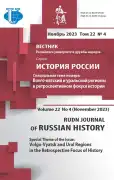Положение религиозных общин в национальных автономиях СССР в 1985-1991 гг.: на примере Хакасской автономной области
- Авторы: Дашковский П.К.1, Гончарова Н.С.1
-
Учреждения:
- Алтайский государственный университет
- Выпуск: Том 22, № 4 (2023): Волго-вятский и уральский регионы в ретроспективном фокусе истории
- Страницы: 680-695
- Раздел: СТАТЬИ
- URL: https://journal-vniispk.ru/2312-8674/article/view/321927
- DOI: https://doi.org/10.22363/2312-8674-2023-22-4-680-695
- EDN: https://elibrary.ru/JXELJS
- ID: 321927
Цитировать
Аннотация
Рассмотрено положение религиозных общин в Хакасской автономной области в контексте государственно-конфессиональной политики СССР в период перестройки в 1985-1991 гг. Исследование проводилось на основе делопроизводственной документации государственных советских, партийных, учреждений и религиозных объединений, хранящихся в Национальном архиве Республики Хакасия и Государственном архиве Красноярского края, а также нормативно-правовых документов. В процессе исследования установлено, что в Хакасии, как и во всей стране, с 1985 г. происходила активизация религиозной жизни. При этом Уполномоченные Совета по делам религий при СМ СССР по Красноярскому краю характеризовали религиозную обстановку в Хакасии как неспокойную еще с 1960-х гг. и просили о выделении отдельной должности для данной национальной автономии. Установлено, что наибольшая часть религиозных общин в регионе относилась к разным направлениям протестантизма, хотя также присутствовали последователи православия, католичества, ислама. В протестантских общинах происходило усиление миссионерства, а в ряде случае наблюдалось стремление уйти от контактов с органами власти. Либерализация политики государства не всегда находила адекватное отражение в действиях органов власти Хакасской автономной области. Установлена взаимосвязь этнического и религиозного процессов. Отмечается склонность хакасов к пятидесятничеству и течению свидетелей Иеговы, представителей немецкой и польской национальностей к общинам католиков, лютеран, адвентистов седьмого дня. Кроме того, в регионе зафиксирована активизация проповеднической деятельности религиозных лидеров из Швеции и США.
Об авторах
Петр Константинович Дашковский
Алтайский государственный университет
Автор, ответственный за переписку.
Email: dashkovskiy@fpn.asu.ru
ORCID iD: 0000-0002-7625-5865
доктор исторических наук, профессор, заведующий кафедрой регионоведения России, национальных и государственно-конфессиональных отношений
656049, Россия, Барнаул, ул. Димитрова, 66Наталья Сергеевна Гончарова
Алтайский государственный университет
Email: znsgnsp@mail.ru
ORCID iD: 0000-0002-4987-760X
магистр религиоведения, лаборант кафедры регионоведения России, национальных и государственно-конфессиональных отношений
656049, Россия, Барнаул, ул. Димитрова, 66Список литературы
- Alekseeva, L.M. Istoria inakomysliia v SSSR: noveishii period [History of dissent in the USSR: the newest period]. Moscow: Moscow Helsinki Group Publ., 2012 (in Russian).
- Badmaev, A.A., Adygbai, Ch.O., Burnakov, V.A., and Mansheev, D.M. Protestantizm i narody Iuzhnoi Sibiri: istoria i sovremennost' [Protestantism and the peoples of Southern Siberia: history and modernity]. Novosibirsk: Institut arheologii i etnografii SO RAN Publ., 2006 (in Russian).
- Burnakov, B.A. “Piatidesiatniki v Khakasii [Pentecostals in Khakassia].” Problemy istorii, filologii, kul'tury, no. 15 (2005): 449-456 (in Russian).
- Dashkovskiy, P.K., and Dvoryanchikova, N.S. Sovetskaia i rossiiskaia gosudarstvenno-konfessional'naia politika na iuge Zapadnoi Sibiri [N.S. Sovetskaia i rossiiskaia gosudarstvenno-konfessional'naia politika na iuge Zapadnoi Sibiri]. Barnaul: Izd-vo Alt. un-ta Publ., 2022 (in Russian).
- Dashkovskiy, P.K., and Dvoryanchikova, N.S. “Peculiarities of the situation and activities of protestant communities in the Omsk region in the mid-1960s - mid-1980s.” Voprosy Istorii, no. 10-2 (2021): 183-193 (in Russian).
- Khismatullin, I.R. “Gosudarstvennaia natsional'naia politika v SSSR: kliuchevye osobennosti I praktika realizatsii [State national policy in the USSR: key features and implementation practice].” Innovatsionnaia nauka, no. 12 (2017): 228-229 (in Russian).
- Torshin, A.P., ed. Istoriia gosudarstvennoi politiki SSSR i Rossii v otnoshenii religioznykh organizatsii v 1985-1999 gg. [History of state policy of the USSR and Russia towards religious organizations in 1985-1999] Moscow: Olma Media Grupp Publ., 2010: 31-35 (in Russian).
- Kashevarov, A.N. “Gosudarstvenno-tserkovnye otnosheniia v period ‘Perestroiki’ 1985-1991 gg. [State-church relations during the period of ‘Perestroika’ 1985-1991]” Obshchestvo. Kommunikatsiia. Obrazovanie (2015): 109-115 (in Russian).
- Korolev, A.A., Koroleva, L.A., and Molkin, A.N. “Dvizhenie piatidesyatnikov v SSSR. 1950-1980 gg. [Pentecostal movement in the USSR. 1950-1980]” Genesis: istoricheskie issledovaniia, no. 6 (2013): 125-131, https://doi.org/10.7256/2306-420X.2013.6.9378 (in Russian).
- Koroleva, L.A., and Mel'nichenko, O.V. “Sovetskaia partiino-gosudarstvennaia politika v otnoshenii Russkoi Pravoslavnoi tserkvi v 1985-1990 gg. [Soviet party-state policy in relations with the Russian Orthodox Church in 1985-1990.]” Vestnik Volzhskogo universiteta imeni V.N. Tatishcheva, no. 1 (2012): 160-168 (in Russian).
- Lunkin, R.N. “Piatidesiatniki i kharizmaty: edinstvo v mnogoobrazii [Pentecostals and Charismatics: Unity in Diversity].” Religiia i pravo, no. 2 (2007): 31-33 (in Russian).
- Maslova, I.I. “Gosudarstvenno-konfessional'naia politika v SSSR: povorot kursa v 1985-1988 gg. [State-confessional policy in the USSR: reversal of course in 1985-1988]” Izvestiia Vuzov. Povolzhskii region. Gumanitarnye nauki, no. 4 (2015): 43-54 (in Russian).
- Nikol'skaya, T.K. Russkii protestantizm i gosudarstvennaia vlast' v 1905-1991 godakh [Russian Protestantism and state power in 1905-1991]. St. Petersburg: European University Press at St. Petersburg Publ., 2009 (in Russian).
- Nikol'skaya, T.K. “Revival or Crisis? Challenges of ‘Perestroika’ for the Confessions of Russian Protestantism.” Nations and Religions of Eurasia, no. 2 (2021): 121-131, https://doi.org/10.14258/nreur(2021)2-09 (in Russian).
- Odintsov, M.I. Gosudarstvo i tserkov' v Rossii. XX vek [State and church in Russia. XX century]. Moscow: Luch Publ., 1994 (in Russian).
- Odintsov, M.I. “Rossiia stroit svetskoe gosudarstvo (1985-1997) [Russia builds a secular state (1985-1997)].” State, Religion and Church in Russia and Worldwide - Gosudarstvo, religiia, tserkov' v Rossiii za rubezhom, no. 3-4 (1997): 134-172 (in Russian).
- Serova, E.A. “Communities of Evangelical Christians-Baptists of the Kemerovo region in the mid-1940s - the first decade of the 2000 s.” PhD thesis, Kemerovo, 2013 (in Russian).
- Shcherbak, A.N., Bolyachevec, L.S., and Platonova, E.S. “Istoriia sovetskoi natsional'noi politiki: Kolebaniia maiatnika? [History of Soviet national policy: Pendulum swings?]” Politicheskaia nauka, no. 1 (2016): 100-123 (in Russian).
- Shkarovskii, M.V. RPC v 20 v. [ROC in the 20th century]. Moscow: Veche; Lepta Publ., 2010 (in Russian).
- Sivatskii, F.L. “Emigratsiia veruiushchikh iz SSSR v 60-80-e gody (na primere piatidesiatnicheskikh organizatsii Krasnoiarskogo kraia) [Emigration of believers from the USSR in the 60-80s (using the example of Pentecostal organizations in the Krasnoyarsk Territory)].” In Prava cheloveka v Rossii: proshloe i nastoiashchee. Sbornik dokladov i materialov nauchno-prakticheskoi konferentsii, 109-112. Perm: Izdatelstvo gazety Zvezda Publ., 1999 (in Russian).
- Yarkov, A. P. “Islam of the Khakasia (In the Context of the Idea of ‘All Turks Are Muslims’).” Narody i religii Evrazii, no. 16 (2018): 99-110, doi.org/10.14258/nreur(2018)3-09 (in Russian).
Дополнительные файлы









